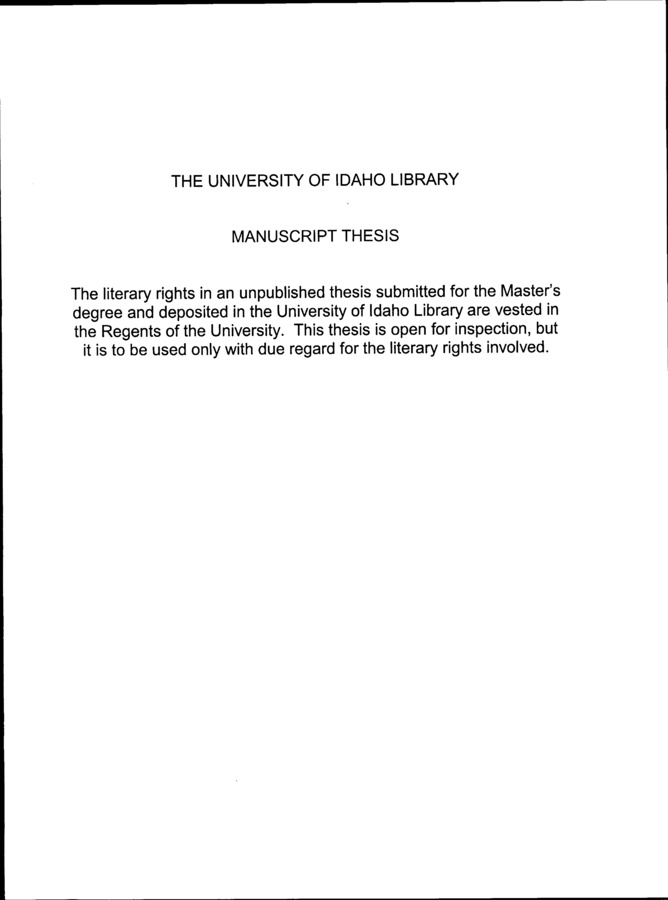PDF
Hydrogeological characterization of dredge materials and fluvially deposited tailings at Cataldo Mission Flats Coeur d'Alene River, Idaho Item Info
- Title:
- Hydrogeological characterization of dredge materials and fluvially deposited tailings at Cataldo Mission Flats Coeur d'Alene River, Idaho
- Authors:
- Gill, Steve W.
- Contributors:
- Idaho Water Resources Research Institute; IWRRI
- Date:
- 2003-05
- Description:
- The hydrogeologic system in the vicinity of the Cataldo Mission Flats, Kootenai County, Idaho, on the Coeur d'Alene River was investigated during the period June 1997 through March 1998. Along this reach, cadmium, lead, and zinc concentrations in soil and pore water are known to be elevated as a result of historic mining activity within the Coeur d'Alene watershed. In order to identify sources of heavy metals release to the river, a conceptual hydrogeological model and metals loading analyses were completed along the subject reach. Based on the results of the hydrogeologic investigation completed at 23 groundwater and 16 surface water sites, the dredge materials constitute a perched water table system that show little, if any, connection to the Coeur d'Alene River. Based on the results of an approximate loading analysis (using USGS gaged flows and water sampling) on six sections along the reach, no significant increases or decreases in dissolved cadmium, lead, or zinc loadings were identified. These results indicate that no significant inflows of impacted groundwater containing high levels of heavy metals can be identified along the Cataldo Mission Flats reach. From a remedial perspective, this suggests that large-scale excavation of the dredged materials along this reach is not necessary and that attention should be focused on remediation and stabilization of impacted and erodible material, which has the potential to be suspended during high flow times. Based on these results, it is recommended that in areas where erodible and impacted dredged materials have been identified, which are not well vegetated, these materials should be stabilized by armoring or using heavy metals-tolerant vegetation. Where a riparian environment is established over impacted dredge materials, these bank areas should be stabilized so as to promote continual development of the riparian zone and minimize resuspension of the sediments and destruction of the riparian zone during high flow events. An additional recommendation is that a similar multi-location loading study of dissolved and suspended metals be repeated during high flow when bank sediments are being resuspended by erosion to identify specific locations of sediment loading.
- Subjects:
- dredging sediments heavy metals hydrogeology
- Location:
- Coeur d'Alene River
- Idaho County:
- Shoshone County
- Latitude:
- 47.56
- Longitude:
- -116.38
- Collection:
- Coeur d'Alene Basin
- Source:
- University of Idaho
- Publisher:
- University of Idaho
- Contributing Institution:
- University of Idaho
- Type:
- Text
- Format:
- application/pdf
- Cataloger:
- wbv
- Date Digitized:
- 2012
- Language:
- eng
Source
- Preferred Citation:
- "Hydrogeological characterization of dredge materials and fluvially deposited tailings at Cataldo Mission Flats Coeur d'Alene River, Idaho", Idaho Waters Digital Library, University of Idaho Library Digital Collections, https://www.lib.uidaho.edu/digital/iwdl/items/iwdl-cda_gill_2003.html
Rights
- Rights:
- In copyright, educational use permitted. Educational use includes non-commercial reproduction of text and images in materials for teaching and research purposes. For other contexts beyond fair use, including digital reproduction, please contact the University of Idaho Library Special Collections and Archives Department at libspec@uidaho.edu. The University of Idaho Library is not liable for any violations of the law by users.
- Standardized Rights:
- http://rightsstatements.org/vocab/InC-EDU/1.0/

